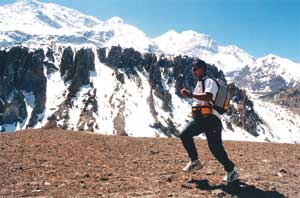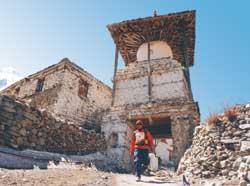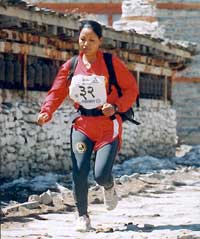 It's not called the "mother of all marathons" just for fun. Along with the shorter Everest Marathon, this is one of the most gruelling races on earth, and is recommended only for the most physically-fit, endurance-tested and acclimatised of atheletes. Normal marathons are 42.5 km runs through flat city streets. Now take that race, multiply it by nine days and add vertical segments. And you have the Annapurna Mandala Marathon.
It's not called the "mother of all marathons" just for fun. Along with the shorter Everest Marathon, this is one of the most gruelling races on earth, and is recommended only for the most physically-fit, endurance-tested and acclimatised of atheletes. Normal marathons are 42.5 km runs through flat city streets. Now take that race, multiply it by nine days and add vertical segments. And you have the Annapurna Mandala Marathon. The race is organised every year by the Himalayan Racers Association in France in collaboration with Mandala Treks in Kathmandu. This year's just-concluded third annual race had 31 participants of which nine were Nepalis, one runner from Greece, one British, one German, and the rest from France.
The race starts at the road-head in Besi Sahar, and follows the Marsyangdi River up to Manang, over the Thorung La to Muktinath, Jomsom and down the Kali Gandaki, up again to Ghorepani and down to Dhampus near Pokhara. It is a horizontal distance of 325 km, but add the ups and downs and you have a marathon designed by a masochist to inflict maximum punishment on a runner.
The Annapurna marathon has everything: altitude variation, stupendous scenery (although runners don't have time to sit around and admire the view), and a geographic diversity of going from the steep southern slopes of the Himalaya to the arid rainshadow of trans-Himalayan Manang and Mustang. Besi Sahar is at the bottom of the semi-tropical valley at barely 800 m above sea level, and Thorung La is at 5,416 m. Competitors had a day to acclimatise in Manang, and this year a side-run to Tilicho lake was also added before the runner made a dash for the pass over the hump.
Unlike the Everest Marathon, which is shorter, the Annapurna run is a circuit and doesn't go through the same area twice. The race also passes some of the big names in Himalayan peaks: the Annapurnas, Himalchuli-Manaslu and Dhaulagiri.
Says Bruno Poirier of the Himalayan Racers Association, who is organiser and a runner himself: "To run the Annapurnas with only a backpack and local hospitality is the fun part. And it's been going very smoothly, the logistics are great, and this year it was one of the best organised." The French have a special place in their hearts for Annapurna, after all it was in 1952 that a French expedition led by Maurice Herzog scaled Annapurna I and the mountain became the first eight thousander ever to be climbed. Everest was climbed two years later.
Back in Kathmandu this week from the run, Poirier is already planning for the 2003 marathon. He intends to make it even longer by starting the race at Karputar near Begnas Lake instead of Besi Sahar, the trail will then join the existing Manang route near Bhulbhule. "Maybe next year we will get even more runners from all over the world," says Poirer.
All runners have to be registered, they carry a mandatory checklist of items including provisions and equipment up to ten kg. They can carry extra material, but that will weigh them down. The beginning of every run is flagged off, and there is a mid-point control check along the way, and then it is all the way to the night halt. The daily timings are added up for the totals for each runner.
 There is a strong competition among the marathoners, but also a feeling of camaraderie. There is code of conduct for runners who have to help those in need along the way. For instance, not helping an injured or incapacitated fellow-runner gets you a punishment of 10 hours added to your final time. A French runner this year was penalised for not helping a fellow-Frenchman. There are also strict do's and don'ts about not acting arrogant, or pushing locals or other trekkers out of the way. Runners are also encouraged to pick trash, and not be generally obtrusive.
There is a strong competition among the marathoners, but also a feeling of camaraderie. There is code of conduct for runners who have to help those in need along the way. For instance, not helping an injured or incapacitated fellow-runner gets you a punishment of 10 hours added to your final time. A French runner this year was penalised for not helping a fellow-Frenchman. There are also strict do's and don'ts about not acting arrogant, or pushing locals or other trekkers out of the way. Runners are also encouraged to pick trash, and not be generally obtrusive. Many marathoners stop along the way at local tea houses for rest, but the more competitive ones race straight through the trail eating their high-calorie bars and drinking water while on the run.
This year, locals along the way gathered in large numbers to cheer the runners along. Nepali participants got loud cheers and shouts of encouragement. And the Nepali runners did the country proud. Of the seven Nepali participants, the first five winners were Nepali.
Dacchiri from Takshindu was number one with a time of 30 hours 43 minutes and 54 seconds. He overtook last year's winner, Nar Bahadur Shah, on the downhill after Thorung. Shah, who is with the Royal Nepal Army, timed 32 hours 43 minutes and 54 seconds. Sumba Sherpa also from Thaksindu came third with 33 hours 31 minutes and 40 seconds. In fourth place was Babu Raja Shrestha, a poultry farmer from Thankot who has been an athlete all his life.
The first among the European runners was Poirier himself, who came sixth clocking 36 hours 30 minutes and 41 seconds. With the runs, and the stellar performance of the Nepalis, the marathon is registering a lot of interest among locals along the Manang trail. Local tea shops are encouraged by the added business during times of a trekking slump. In Manang, the runners got a rousing send off and a cultural performance with music and dance before they headed off for Thorung La. Village youth clubs had inquiries about joining in next year's marathon.
At this rate, it would not be surprising if Nepalis start bagging medals in Olympic and other marathon venues. After all, with the Annapurna Mandala Marathon behind them, 42.5 horizontal km at sea level should be a piece of cake!
(Padam Ghaley is co-director of Mandala Treks and was in charge of the local logistics of the 2002 Annapurna Mandala Marathon. He was assisted by Bhim Tamang and Jerome Eudu. To join the 2003 Marathon send biodata to Mandala Treks, phone 977-1-412 438 email: [email protected])
Marathon woman
RAMYATA LIMBU
 She's run the Atlanta Olympics, the Kathmandu Marathon, the SAF games and done the run in Hong Kong. But running in the Annapurna Mandala Marathon was a totally different experience for Bimala Rana Magar who says she is not using to running uphill. "Before this, the only uphill I'd done was run up Swyambhu," she laughs. Also, she is used to running in a sando vest and shorts, not with 10 kg on her back.
She's run the Atlanta Olympics, the Kathmandu Marathon, the SAF games and done the run in Hong Kong. But running in the Annapurna Mandala Marathon was a totally different experience for Bimala Rana Magar who says she is not using to running uphill. "Before this, the only uphill I'd done was run up Swyambhu," she laughs. Also, she is used to running in a sando vest and shorts, not with 10 kg on her back. Back now in Kathmandu Bimala, 28, is sore but happy. "I'm so glad I completed the marathon without succumbing to high altitude." Bimala finished 18th out of 31 runners.
Bimala has run from Kathmandu to Hetauda, the old route, from Kathmandu to Melamchi as part of her long distance training. Five months back she and a bunch of long distance runners ran from Kathmandu to Muktinath. They were celebrating the 50th birthday of Nepal's most famous marathoner, Baikuntha Manandhar. "That was the first time I had been at a reasonably high altitude," says Bimala. "The route was much easier than the Annapurna Mandala Trail."
At Thorung Phedi, the runners were roused at 3 am before they made their way upwards to the 5400m snowbound Thorung La, and down to Marpha in Mustang. Bimala's preparation for the marathon consisted of her regular 90-minute run along Kathmandu's Ring Road, and her diet of dal-bhat. "If I'd been training for the 3,000m or 1,500m events, which I used to run, and was in a special training camp, I'd probably be getting coached and extra diet. But marathon running in Nepal usually means you're on your own."
She considers herself fortunate to have a family, especially an elder brother, who encouraged her to run. "I started running late, after completing high school. I used to watch runners from the parapet and get the urge to join them." But she doesn't see an increasing number of women join the sport.
Bimala began training for marathons in 1993, and came third among women in the 42km Kathmandu Marathon in 1994, her first event. The following year, she came second. In the 7th SAF games in Madras she came fourth, and she came 11th in the 1999 Hong Kong Marathon.
In between running, Bimala is busy at her job which is preparing voter's identity cards. "While attending college, I took some computer courses which helped me get a job. One does have to work."
Of course it would be ideal if she got a company to sponsor her for what she does best. "My dream is to become a coach. I can teach other young people what I have learnt. One has to recognise, train, and nurture talent. Despite the odds, she's keen to go the distance. "If I get a sponsor and someone to train me, I'm keen to do the Annapurna to Everest marathon this autumn."


